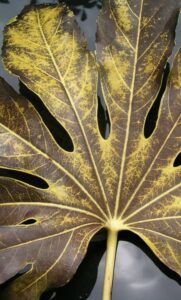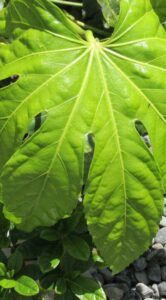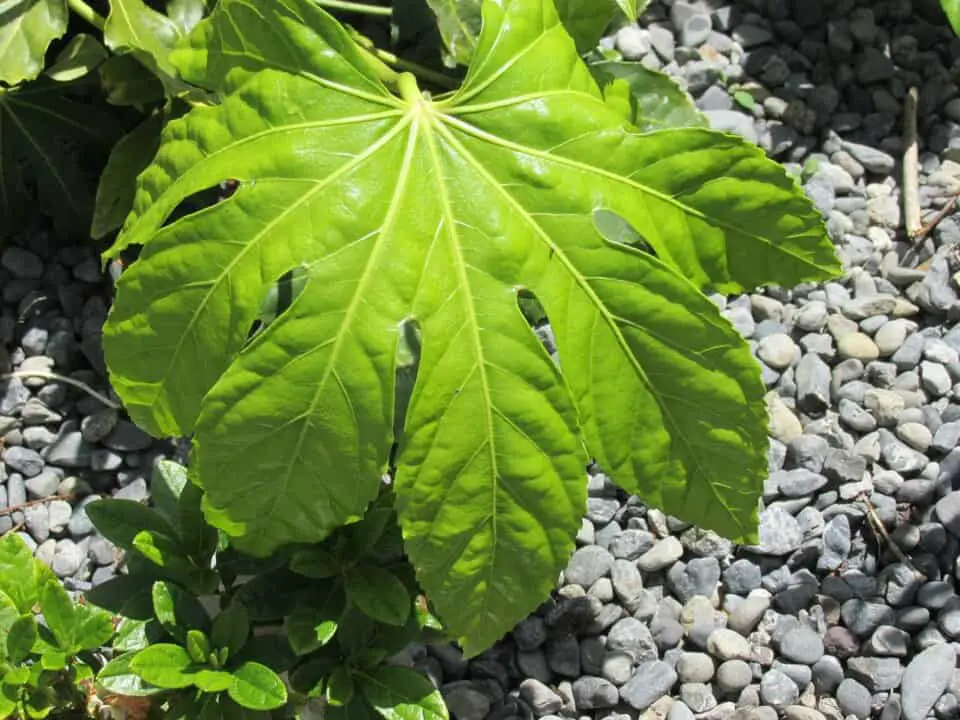Some links in the post are affiliate links and I get a commission from purchases made through some links found in the post.
Do you love container gardening? I do! But instead of using crafty containers (which look incredible), I take the easy way out by buying pots.
But the premise is the same – housing plants and giving them what they need so they can beautify any space.
Once I started container gardening, I realized how picky some plants could be about their potting mixes. And I learned that to offer your plant the best chance of survival, you must understand what it needs from the very start.
So, what’s the case with the fatsia japonica? I almost jumped for joy when I looked up this plant. It’s one of the few that does not give you much trouble when planting and feeding it.
You can literally walk into any home gardening store and pick up a potting mix that would work wonders for it.
Better yet, you can easily make a potting mix from scratch, and the plant would not bother you with stunted growth or other issues.
The soil of a fatsia japonica needs to be well draining, good at retaining moisture and well aerated. The pH should be slightly acidic, between 6-7 and it does well in a nutrient rich potting mix as well as heavy clay or light soil.
Of course, you would also need to cater to its other needs, including watering and feeding.
In this guide, I take you through what you should include in your fatsia japonica’s potting mix. I also throw in some of the best commercial potting mixes so you can get right to planting this fantastic houseplant.
What Soil Nutrients Does a Fatsia Japonica Need?
You will be happy to know that the fatsia japonica does not have extensive soil needs. It does well in any nutrient-rich potting mix. The essential nutrients include:
- Nitrogen,
- Phosphorus, and
- Potassium
Micronutrients are also essential for its growth. And even if the soil does not have many nutrients, the plant still does well.
You can use just about any potting mix and replenish the plant with fertilizer with a balanced fertilizer occasionally.
While the plant may not be too picky about nutrients, you should note that it does best when it has adequate nutrient access.
What Type of Soil Should You Use for Your Fatsia Japonica?

The ideal soil should be:
- Well-draining: The fatsia japonica does not like sitting in water for too long,
- Good at retaining moisture: Your plant does well in moist conditions, as these allow it to take up adequate water for food production, and
- Well aerated.
To achieve this balance, you can count on clay, loam, or even chalk soils. Or you can invest in a good potting mix.
You may also like: 10 most common fatsia japonica problems & how to fix them
What Are the Signs You Are Using the Wrong Soil for Your Fatsia Japonica?
If your choice of a potting mix does not meet the criteria above, you will notice the following signs:
- The soil will be perpetually dry no matter how often you water it,
- The soil will remain moist even if you maintain a regular watering schedule. Over time, you may notice mold on its surface and a foul smell emanating from the soil – these are signs of root rot which owe to overwatering,
- The plant’s leaves will appear pale and may start falling off: This is a sign of low nitrogen,
- The plant’s leaves may appear purple: Take this as a sign that the plant needs more phosphorus, and
- Pests may start infesting your plant: These come about when the plant is weak owing to unfavorable growing conditions.
If you notice such changes in your plant and can rule out other possible causes, it may be time to repot your fatsia japonica.
You nay also like: Why are your fatsia japonica leaves turning yellow
What PH Should the Soil Be for A Fatsia Japonica?
The ideal pH for a fatsia japonica should be slightly acidic to neutral, ranging between 6 and 7. Below is how you can achieve such a range for your plant:
- Start by testing the pH of your potting mix: You can find a pH testing kit from most gardening stores. These are easy to use and will give you an accurate reading in minutes. Guess what? These kits also allow you to test the level of nutrients in your soil, most notably nitrogen, phosphorus, and potassium. And you know just how important these are to your plant’s growth.
If your soil is within the 6 to 7 range, you are good to go and can plant your fatsia japonica. But if it is outside the range, please keep reading:
- If the soil range is below 6, your soil is highly acidic, which is not ideal for your fatsia japonica. You can increase its pH by adding alkaline components like:
- Wood Ash,
- Lime,
- Dolomite Lime,
- Crushed Egg Shells, and
- Calcium Hydroxide.
- A range above 7 indicates a highly alkaline potting mix. You can lower the pH by adding acidic materials like:
- Sulfur,
- Leaf Mold,
- Compost,
- Pine Needles,
- Ericaceous Compost,
- Vinegar/ Lemon, and
- Cottonseed Meal.
Better yet, you can get a ready potting mix that has its pH stated to avoid amending the soil. Let’s check out some of the best mixes for your plant:
Our 5 Recommended Soils for A Fatsia Japonica
You can always make a potting mix using locally available materials. Or you can choose an easy way out by relying on potting mixes that have been crafted by the greats in the gardening world. So, which ones take the cake and why?
1) Miracle-Gro Indoor Potting Mix
This mix comprises a blend of essential materials like coconut coir which add to its water retention rate.
Plus, with the lack of compost or bark, you can be a step ahead of fungus gnats which will now have a hard time seeking shelter in your soil.
2) Espoma Organic Potting Soil Mix
This mix contains all you want in a good potting mix. With a blend of sphagnum peat moss, kelp meal, alfalfa meal, humus, perlite, and feather meal, this mix works as an excellent soil mix.
You can use it when repotting your fatsia japonica or when propagating it the first time.
3) Black Gold All Purpose Potting Soil
How about potting your plant and feeding it simultaneously? That’s what this mix has to offer you!
It features a slow-release technology that seeps nutrients to give your fatsia japonica a healthy start. You cannot go wrong with pumice, forest humus, and worm castings.
4) Premium All Purpose Potting Soil
Like the Black Gold potting mix, this blend also features a slow-release fertilizer. It comprises dolomite lime, perlite, peat moss, and softwood bark. Moreover, it also has a wetting agent.
This combination is what your fatsia japonica needs for a solid and healthy start.
5) Burpee Premium Organic Potting Natural Soil Mix
Rather than keep your plant waiting, this natural mix releases all essential nutrients immediately, allowing your plant to put them to good use.
It features plant food and coco coir, vital to healthy plant development. Plus, it has a high water retention rate, which allows you to water your fatsia japonica less often.
Any of these mixes should be suitable for your fatsia japonica.
Does A Fatsia Japonica Need Ericaceous Soil?
If you’ve grown acid-loving plants in the past, you have likely come across ericaceous soil – this is highly acidic soil that is best for plants that thrive in such environments.
This soil, which has a pH of 4 to 5, has a high moisture retention rate and is excellent at warding off pests. However, your fatsia japonica would not do too well in such soil as it prefers slight acidity or neutral soils. It prefers a pH of about 6 to 7.
But wait – before you abandon the idea of ericaceous soil, here’s what you need to know – your fatsia japonica could need this soil.
Why? Ericaceous soil is highly acidic, and if your potting mix has a highly alkaline pH, you can lower it by incorporating this soil!
But if the soil pH is acceptable, there’s no need to add this soil as it would only make it more acidic and unsuitable for your plant.
You may also like: Can I grow a fatsia japonica in a pot & placement tips
How To Repot a Fatsia Japonica
 A healthy fatsia japonica grows several inches taller and broader each year. As such, it is always important to repot it in a new container. But how should you do this? First, you must look for signs that the plant needs repotting. These include:
A healthy fatsia japonica grows several inches taller and broader each year. As such, it is always important to repot it in a new container. But how should you do this? First, you must look for signs that the plant needs repotting. These include:
- Stunted or slow growth: This shows that the plant’s roots cannot absorb adequate nutrients and water. They are possibly rootbound.
- Roots sticking out of the soil surface or out of the drainage holes: When the container becomes too small to hold the plant’s roots, they stick out of the container to make room for new growth – This is another vital sign that your plant is rootbound.
- Water welling up the soil surface after a bit of watering: Rootbound roots take up much space, forcing water to remain on the surface rather than move through the potting soil.
It’s always best to wait at least a year before repotting the plant. However, if you notice the signs above, it’s time to start moving. Here’s how you repot a fatsia japonica:
1) Repot the plant in spring and summer
Repotting usually causes transplant stress where the plant takes some time to acclimate to its new home.
The acclimation is seamless in the active growing season, as the plant has enough energy to heal and keep growing. But in late fall and winter, the plant goes dormant, and such a move can weaken it considerably.
2) Choose a pot that is one or two sizes bigger than the current one
A pot that is much bigger than this will hold more soil and thus more water, introducing the risk of waterlogging. Moreover, leaving your fatsia japonica in a large pot changes its priorities. Rather than focusing on growing upwards, the plant will spend more time extending its roots, stunting its growth. Ensure the pot has enough drainage holes.
3) Fill the new pot with your choice of potting mix to half the pot’s height
The fatsia japonica is not incredibly choosy, and you can go with any of the commercial mixes above. They are ideal as they contain all that a plant needs to get a good start in its new home as it acclimates.
4) Wet the potting mix in the current pot
This makes it easier to wiggle the plant out of the pot without damaging its roots. The more you disturb its roots, the more time it takes to acclimate.
So, wet the potting mix, and give the plant about 20 minutes to absorb the water before removing it from the pot.
5) Transfer the fatsia japonica to the new pot and fill the pot with the potting mix, leaving at least 2 inches between the soil and the top of the pot:
You want to leave adequate space to water the plant. Do not compact the soil with your hands.
The fatsia japonica prefers well-aerated soil, and compacting can hinder this. Instead, water the potting mix until the excess water drains from the drainage holes.
6) Move the plant to a spot with partial or full shade
This will allow it to acclimate to its new home. Direct sunlight can damage the plant’s leaves and make it harder for it to thrive in the new potting mix.
If your fatsia japonica appears droopy for the days following the repotting, this is normal. It takes a while to get used to the new potting mix.
Ensure you keep giving it water as necessary and do not feed it in the following weeks. A month after repotting, you can resume the usual feeding schedule.
You may also like: Fatsia japonica light requirements
Final Thoughts
Once your fatsia japonica has an excellent potting mix, you will notice it grows at a steady rate of about 8 inches a year. Not bad, huh?
And if you want to make it grow faster than this, you can! All you need is to add a weak liquid fertilizer to the water when watering the plant.
Do this twice every month in its active growing seasons. And in the colder months, hold back on the feeding to avoid damaging its roots.
If you’ve done all this and still think your plant has stunted growth, poke around other issues and see what the problem could be.
For example, the plant may not be getting enough water to sustain its food production. Or the lighting could be inadequate.
After all, the fatsia japonica is not too picky about soil. And most times, growth and developmental issues will arise from other unmet needs.
Happy Gardening!






